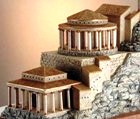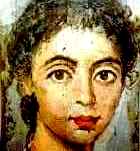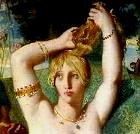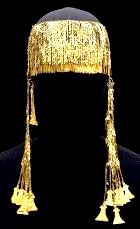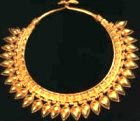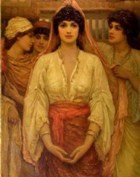Paintings of Esther in the Bible
‘Queen Vashti deposed’, Ernest Normand, 1890
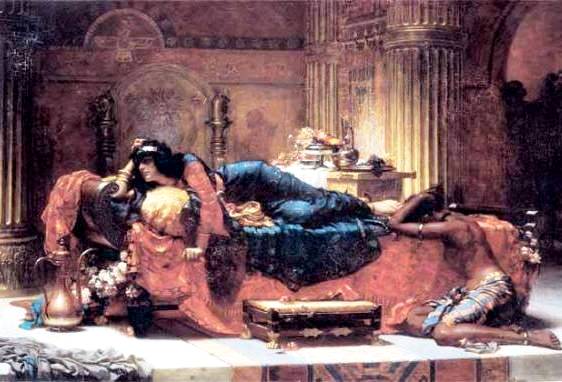
Unlike Esther, Vashti was born into a noble family and married to King Ahasuerus, but she was now disgraced (see ‘Wife Disobeys Husband’ at the bottom of this page). She had refused to appear before her husband’s drunken friends, and her enemies at court persuaded the King that this act of disobedience would set a bad example to all the women in his kingdom – who would refuse to obey their own husbands. They encouraged him to exile her from his presence, and so she was banished to a back room of the palace harem where she would remain for the rest of her life.
Normand’s wonderful painting shows Vashti’s despair. She has lost everything – her political power, her dignity, her chance to bear children, her friends and supporters, her entire future. She was now a prisoner – well-fed and well-housed perhaps, but permanently trapped and alone.
Bible reference: Book of Esther (see end of this page)
‘The Banquet of Ahasuerus’, Aert de Gelder, circa 1680
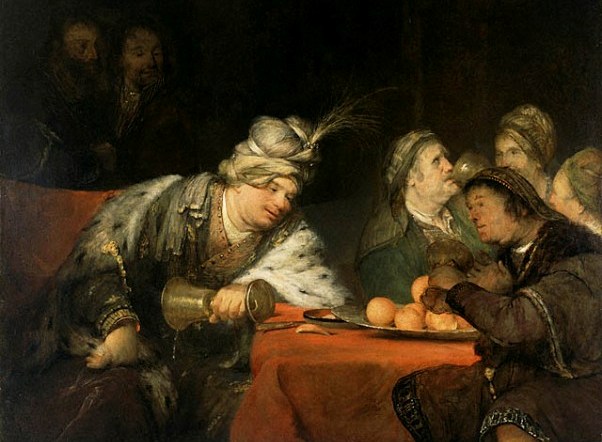
Ahasuerus is banqueting with his courtiers, and has taken rather too much wine. He lolls drunkenly against the table, the wine spilling from his goblet. This is the moment when he will send for the beautiful Queen Vashti, to parade before his drunken friends and show how beautiful she is.
Too much wine makes silly people sillier, and nowhere is this more true than in the story of Ahasuerus. Gone is the nobility a king ought to show, gone is his dignity. He will be putty in the hands of the courtiers lurking in the background. Some of them are drunk as well but some are not, and they lurk like wolves ready to seize their moment. It is these men who will persuade Ahasuerus he should get rid of Queen Vashti – a woman with more sense and character than her husband will ever have. No savage political cartoon ever said it better.
‘La Toilette d’Esther’ by Theodore Chasseriau, 1841
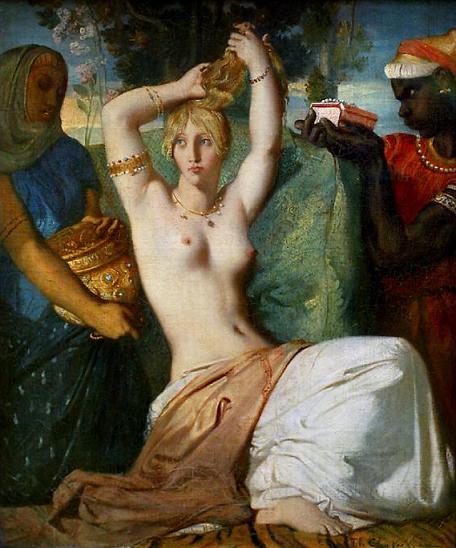
Esther’s beauty is apparent, as she is helped by her maidservants to complete her toilette. The process of preparation for entry into the King’s harem lasted twelve months.
When Madame de Pompadour was plucked from obscurity and made the mistress of Louis XV, she was first put through a four-month-long period of training. During that time she learnt all the ins-and-outs of life in a royal court – who was who, the protocol for every event and action, the way to look and behave. Esther and the other candidates for the position of Ahasuarus’ wife went through the same period of training. It was not simply a period of beautification, as this painting implies, but a complicated training program at which Esther excelled.
Bible reference: Book of Esther 2:7-10 (see end of this page)

Layout of the royal city of Persepolis
‘Esther’, often listed as ‘Vashti’, Edwin Long, 1878
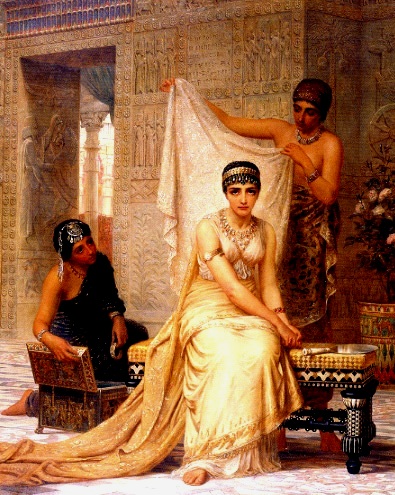
Esther is being groomed to take up her role as a wife of King Ahasuerus. Her face shows resignation and a certain foreboding. She already knows enough of the king’s personality to realize the danger she is in, and the difficult road ahead of her.
This painting is sometimes listed as ‘Vashti’, the queen who refused to parade before her drunken husband’s friends. She was banished from the King’s presence forever, and became a forgotten woman, lodged in a back room of the royal harem.
Vashti was not, like Esther, plucked from obscurity. She was from one of the great noble families of the vast Persian Empire, and had been trained from birth to assume the position of Queen. She was probably the representative of a powerful political faction at court. It was this power, and not really her disobedience of her husband’s command, that was her downfall. Ahasuerus would never have thought to banish her had he not been egged on by courtiers who led another, opposing court faction. He was later to regret his hasty action, but his royal command, once spoken, could never be rescinded.
Compare Vashti’s jewelry with the real thing: excavated jewelry of a queen at Archaeology: Jewelry
Bible reference: Book of Esther 1 (see end of this page)
‘The Jewish Bride’, Aert de Gelder, 1684
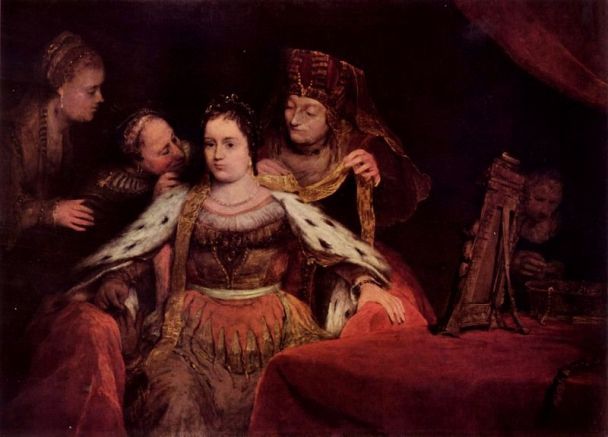
Esther has ‘pleased’ King Ahasuerus, and he has chosen her as his future queen. The touch of ermine on the edges of Esther’s cloak signal to the viewer that this is the moment when she is acknowledged as Queen, replacing the exiled Vashti.
This painting is similar to one Aert de Gelder painted in the same year, but it is more specifically linked to Esther by de Gelder’s use of ermine, a symbol of royalty. The heavy clothing and the encroaching servant women lend the scene a claustrophobic air. Esther is trapped by her own power, and must now take on a double burden: royalty, and a foolish husband.
Bible reference: Book of Esther 2:7-10 (see end of this page)
‘Assuerus Falls in Love with Esther’, Salvador Dali,1964
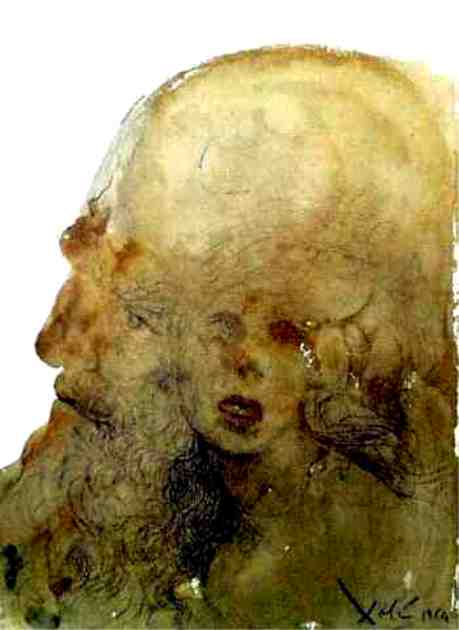
King Ahasuerus/Assuerus has fallen in love with the beautiful young Esther, and she now occupies all his thoughts. He sees her everywhere, can think of nothing else. What love does to people.
Dali was profoundly influenced by two things: Freud’s theory of the Unconscious, and the unconscious dream imagery of Surrealism. His paintings (and lithographs) appear as dreamlike fantasies – as this image clearly shows. At the same time, the technique he used was precise, realistic and highly skilled. In this lithograph a dream-like Esther has taken up residence in the mind of Ahasuerus, floating there, occupying all his thoughts – and in a sense trapped there.
Bible reference: Book of Esther (see end of this page)
‘Esther and Mordecai’, Aert de Gelder, 1685
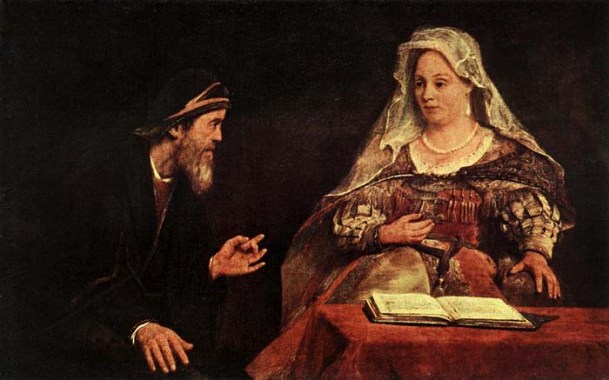
Mordecai advises Esther that she and all the Jewish people are in mortal danger. He urges her to act. She alone can save them. But Esther is in a predicament, since she has not been summoned into the King’s presence for thirty days, and to go unsummoned into his presence will leave her open to a sentence of death. The doubt she feels is clearly written on her face.
The body language in this painting by de Gelder is superb. Mordecai leans forward urgently to stress the importance of what he is saying: Esther must act quickly or they will all die. His left hand reaches out to emphasize what he is saying. Esther seems to be backing away from him, her left hand grasping the rail of the chair in apprehension. She does not want to do what he is urging because it may very well end in her own violent death, but she is beginning to realize that she has no choice in the matter. The moment is reminiscent of the words of Jesus on the eve of the Passion: “Father, if you will, let this chalice pass from me. But if it cannot, let your will be done.”
Bible reference: Esther 4 (see end of this page)
‘Esther Preparing to Intercede with Assuerus’, Rembrandt, 1633
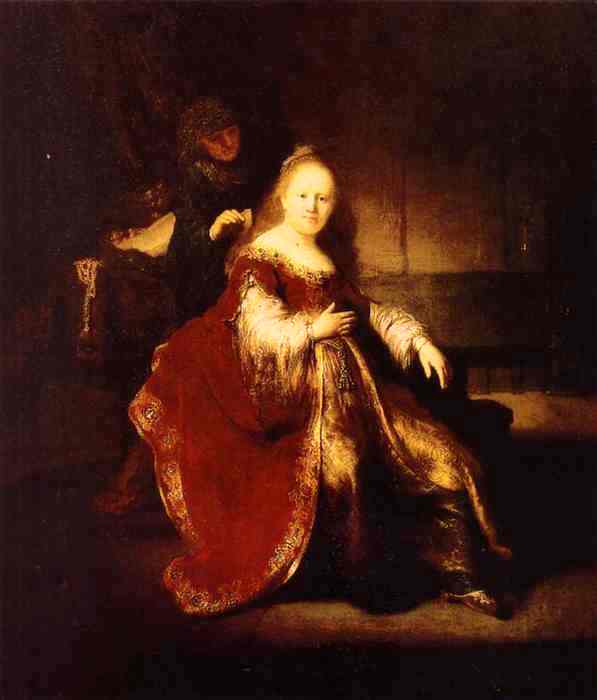
Will she or won’t she go unbidden into the King’s presence? Rembrandt shows the moment of decision as Esther weighs up the danger she is facing if she goes, and her own future and that of the Jewish people if she does not. She has fasted and prayed, and is now dressed in her most beautiful clothing, ready to act.
The crimson of Esther’s dress, and her pale skin, are almost luminous against the dark background. Rembrandt loved to place his subjects against an undefined background, without the usual limits of walls and doors. This highlighted the timelessness of their situation. Despite the presence of her maid, Esther seems to hover in space. She is isolated, alone in what she must do. No-one can help her, or perform the task for her. This is the awful solitude of her position.
Notice that the painting was done in 1633 – the year Rembrandt married his beloved Saskia. He used his wife for many paintings, both religious and classical, and made innumerable studies of her. Never did an artist make better use of his wife – she kept his house, mothered his children, and inspired his pictures.
Bible reference: Book of Esther, 5:1 (see end of this page)
‘Esther’, Sir John Everett Millais, 1865
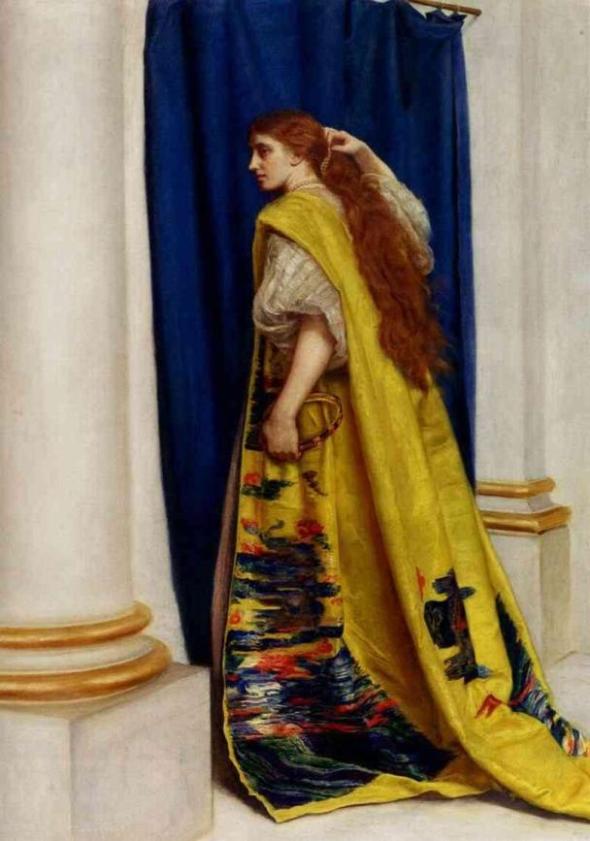
Esther, dressed in royal robes, stands outside the entrance to the throne room of her husband, King Ahasuerus. She raises her right hand to untie the pearls which hold back her thick hair. In her left hand she holds her crown, which she is about to place on her head. This is the moment of decision.
The strong blue, gold and white of this painting accentuates the drama of this moment, as Esther pauses outside the royal throne room of her husband. The robe she wears in the painting was a real one, given to General Gordon by the grateful Chinese emperor after Gordon helped suppress the Taiping Rebellion (1850-64) – though Millais turned the garment inside out, and so it is the lining of the robe that is seen in this painting.
Bible reference: Book of Esther 5:1-4 (see end of this page)
‘Esther before Ahasuerus’, Tintoretto, 1546-7
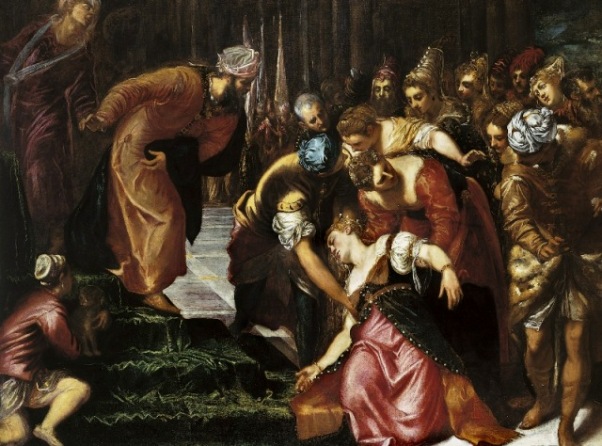
Esther swoons in terror as she approaches the King – the Bible story says her heart was frozen in fear. He steps forward, his bearing full of concern for her. The courtiers are agog at this unexpected behavior on the part of their new Queen.
Tintoretto is famous for the turbulence and drama of his paintings, and this is no exception. It shows a fainting Esther, mentioned in the Greek edition of the story. She swoons when she sees Ahasuerus’ face full of anger, then ‘God changed the spirit of the king to gentleness, and in alarm he sprang from his throne and took her in his arms until she came to herself’. Tintoretto was one of the first artists to show Esther fainting, an idea that was important because it that linked her to the Virgin collapsing at the foot of the Cross. The painting was bought by Charles I, is now the property of Queen Elizabeth, and resides in Buckingham Palace, London.
Bible reference: Book of Esther with Additions 15:1-7
‘Queen Esther Before Ahasuerus’ , Francesco Caucig, 1815
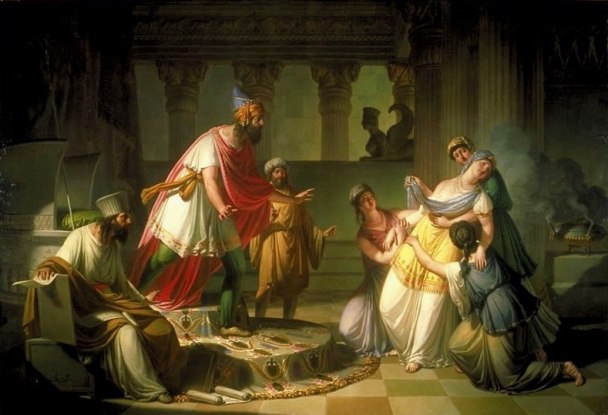
Ahasuerus has risen from his throne and is in the act of stepping forward towards his wife, who falls swooning against her handmaidens. They support her as best they can, as Haman, in the seat of honor beside the King, leans forward, wondering what has prompted this reckless action of Esther’s.
This painting is in the Roman Neo-Classicist style, popular at the time. Paintings of classical or ancient biblical subjects were popular for a number of reasons – they certainly provided beautiful decoration, but they also attested to the owner’s erudition and good taste. This is one of the so-called ‘Fainting Paintings’, in which a rosy-cheeked, beautiful woman appears to faint but may be merely feinting.
Bible reference: Book of Esther with Additions 15:1-7
‘The Swooning of Esther’, Antoine Coypel, 1704
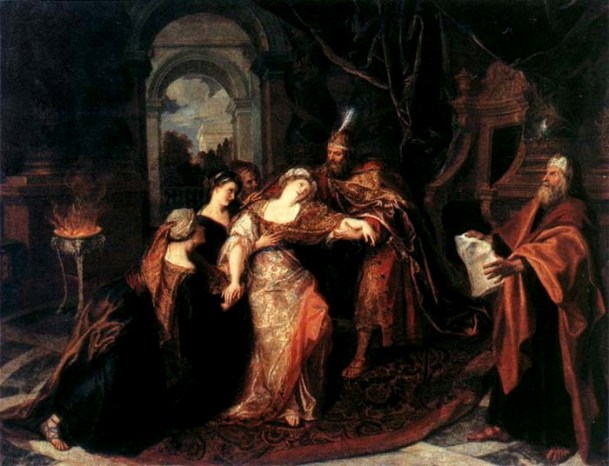
Esther has braved the inflexible protocol of palace etiquette, and gone unbidden into the King’s presence, and now she sinks down onto the rich carpet in a faint. But not only the serving women have moved to support Esther – Ahasuerus himself has leapt forward to catch her falling body.
Another of the ‘Fainting Paintings’. Esther is rosy-cheeked with open eyes, not the usual thing for someone who has fainted from sheer terror but never mind, it is a most beautiful painting. The dark richness of the velvets and silks is wonderfully opulent, Esther’s pale neck and breasts glow in the darkness, and Ahasuerus is suitably solicitous.
Bible reference: Book of Esther with Additions 15:1-7
‘Esther Before Ahasuerus’, Pompeo Batoni, 1738-40
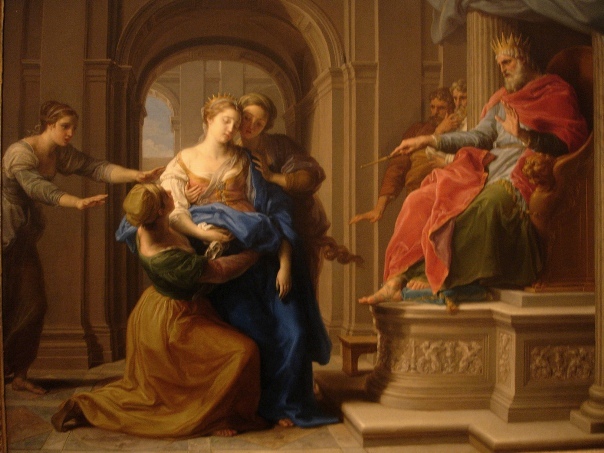
Esther seems more faint than swooning in this depiction of the event in the royal throne room. Ahasuerus is detached here, more so than in other paintings, though he extends the golden scepter towards her.
Batoni was one of the most prolific and respected painters in Rome in the mid-1700’s. He specialized in portrait painting, but his portraits were mostly light-weight characterizations – good likenesses of the subject, but giving no real sense of the personality behind the eyes. The faces in the painting at left are typical of his work: beautifully arranged but giving no sense of the terrifying drama they are living through.
Bible reference: Book of Esther with Additions 15:1-7
‘Esther before Ahasuerus’, Peter Paul Rubens, 1620
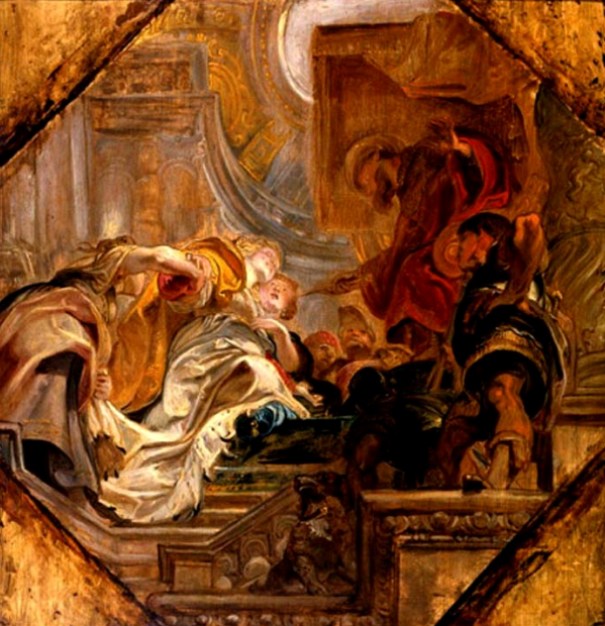
Esther seems to fall towards the viewer as she faints on the steps of the throne. Her two maidservants support her sagging body, and Ahasuerus leans forward to touch her.
Another moment and it seems as if the people suspended above our heads will take a false step and come crashing down. Rubens has used foreshortening to achieve this effect, distorting the proportions of the figures to that they appear to be three dimensional and correctly proportional when seen from below.
Bible reference: Book of Esther with Additions 15:1-7
The famous ‘Fainting Paintings’
‘Esther Before Ahasuerus’, Artemisia Gentileschi
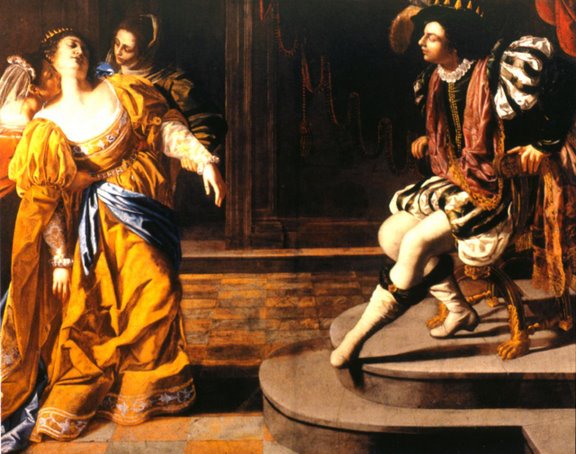
Esther has come, unbidden, into the royal throne room, and now her courage fails her. She begins to fall into a faint, and perhaps this is just as well, since it arouses the King’s sympathy. Is it merely a ploy on her part? Hardly, since the danger for her was real.
Artemisia Gentileschi was interested in the effect that light could have in a painting, and we see here how light in the far left corner of the painting draws the eye away from the center, which would normally be a focus for the eye. She heightens this effect by positioning each of the secondary figures around Esther, centering on her as she droops into unconsciousness. Gentileschi manages to convince us that both the main figures in the painting are sumptuous – not just in clothing and jewelry, but in their personae, in who they are. These are royals we can believe in. Quite an achievement.
Bible reference: Book of Esther with Additions, 15:1-7
‘Esther before Assuerus’, Nicolas Poussin, circa1640
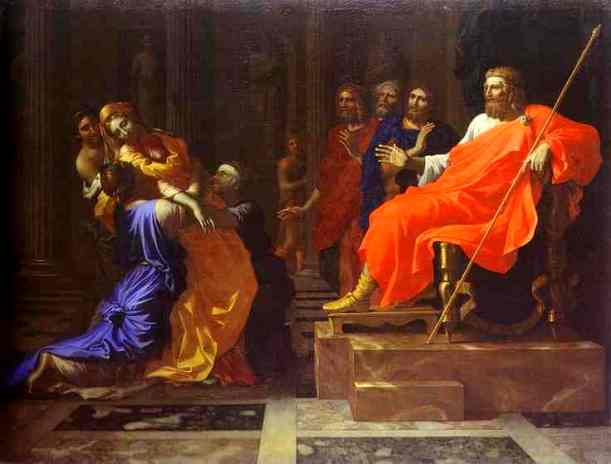
Esther collapses backwards into the arms of her handmaidens, as she faints with terror. Ahasuerus holds the royal golden sceptre in his hand – will he, or will he not, lower it to touch Esther’s head, and so save her from death?
Never mind the composition (which is wonderful) – look at the color! The red pulses with energy and is the main focus of the picture – as a king’s robe surely should. Esther’s dress is gold, the color of luxury and royalty. Her maidservants are dressed in a voluptuous blue. Notice too the consummate foreshortening of the marble floor. Poussin’s skill is breathtaking.
Bible reference: Book of Esther with Additions 15:1-7
Illumination from the ‘Biblia Pauperum’, Hesdin of Amiens, circa1450
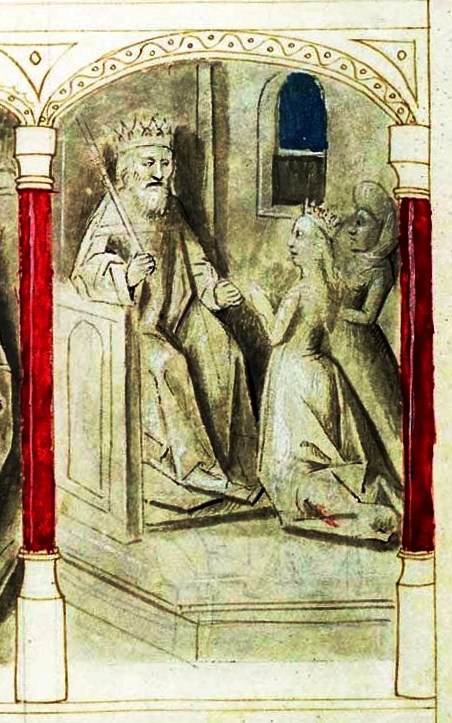
Esther is so terrified of entering the throne room unbidden – knowing her action should be punished by death – that she faints. But in this scene she has recovered from her fainting spell and now asks King Ahasuerus if he will attend a banquet she will arrange in his honor.
This manuscript drawing, done by a French monk some time in the middle of the 1400’s, is taken from a ‘Bible for the Poor’. Pictures were used by members of the clergy to explain the stories of the Bible. People then, as now, responded positively to images and drawings, and the churches of the time were laden with statues and paintings that were used as teaching aids. The ‘Bible for the Poor’ used episodes from the Old Testament as predictions of events from the life of Christ. Esther’s plea to Ahasuerus is a prediction of the plea the Virgin makes to God, on behalf of humanity.
Bible reference: Book of Esther 5:1-4
At the banquet
‘Ahasuerus and Haman at the Feast of Esther’, Rembrandt, 1660
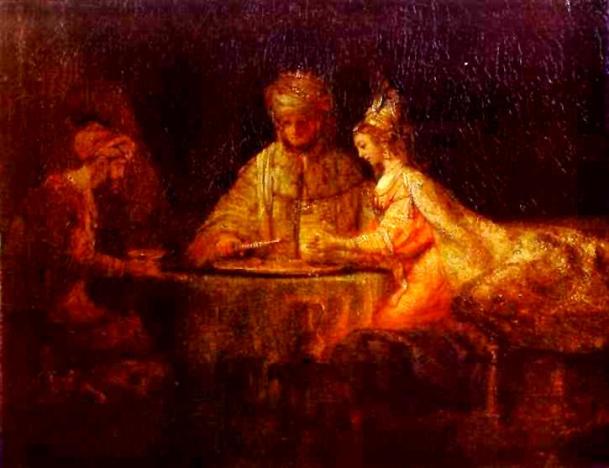
These are three of the four main protagonists in the story. At this moment in the story, Esther has revealed the danger she is in, and appealed to the King’s love for her. He looks at the culprit Haman and raises the golden scepter – that may or may not spell reprieve for his old adviser. Haman himself sits with lowered head, waiting for his fate.
Apart from the dark background, the predominant color in this painting is gold, closely followed by crimson. With this device, Rembrandt emphasizes the opulence and wealth of Ahasuerus’ court, and the royal status of the couple. The drama played out by the three characters is expressed not by violent action, but by the restraint of their demeanor. The calm before the storm. Esther is radiant, her clothing and headdress gleaming with precious stones. Haman’s persona has already withdrawn into the shadows.
Bible reference: Book of Esther, 5-6
‘The Feast of Esther’, Jan Lievens, 1625
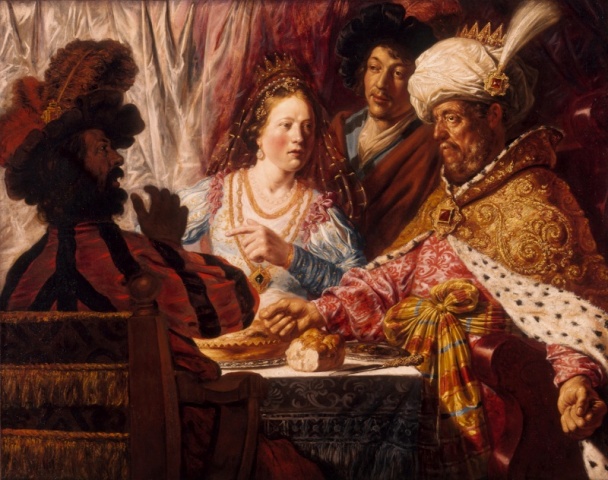
Esther has spoken, and her finger points towards the person she has accused. Her husband the King turns towards Haman for confirmation or denial; his face is calm, enquiring. Haman on the other hand is horrified by what he hears, since he knows he cannot deny the accusation Esther has made.
Lievens was precocious – he began his career as an independent painter at the age of twelve. He was a close friend of Rembrandt’s and the two have much in common in their styles – as can be seen in the painting at left. There is the same sumptuous use of color – see Rembrandt’s three paintings below. Lievens had a long and illustrious career, but when he died his debts were so appallingly large that his children appealed to the courts for the right to refuse their inheritance – which would of course entail paying all his debts.
See Bible Archaeology – ancient jewelry for the sort of jewels Esther wore.
Bible reference: Book of Esther, 7:1-7
‘The Banquet of Esther’, Jan Victors, 1640’s
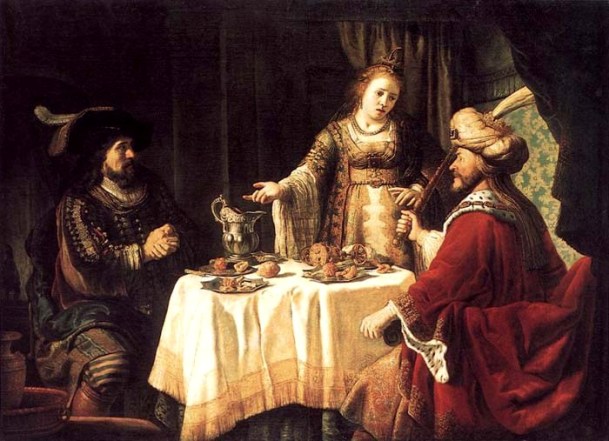
Esther reveals Haman’s plan to her royal husband Ahasuerus, who seems aghast at the thought that he may have inadvertently ordered her death. Haman looks at her with new respect, and an awareness that she, not he, holds all the cards.
I’m sorry, but these people just do not convince me. They seem like good Dutch burghers, dressed for the occasion with glaringly un-Dutch ostentation. The painting simply does not work as a portrayal of the three most powerful people in the vast Persian Empire, in the act of conspiring and taking revenge. What are the people in this painting talking about? Difficult neighbors? Rising interest rates? Barking dogs?
Bible reference: Book of Esther 7:1-10
‘The Feast of Esther’, Frans Francken II, circa 1630
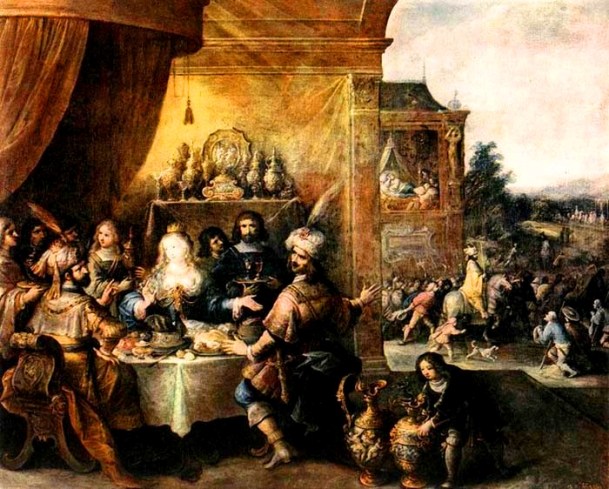
There are three scenes here. In the main image, Esther is seated at the banquet table as she entertains her husband the King and the villain of the story, Haman. Above right we see the insomniac King in his bedchamber, ordering that the records of the kingdom be read to him. Below right Mordecai rides in triumph through the streets, garbed in the royal robes and crown and riding the King’s own horse.
Francken was best known for his small, finely crafted pictures of historical, mythological, or biblical themes, such as the one shown here – see the fine detail in every part of the crowded canvas. His figures are not profoundly human as for example Rembrandt’s are. They are perhaps even a trifle superficial. But they do convey the bustle of humanity as it goes about the business of living.
Bible reference: Book of Esther, 5-6
Haman begs for mercy
‘Festival of Esther’, Edward Armitage, 1865
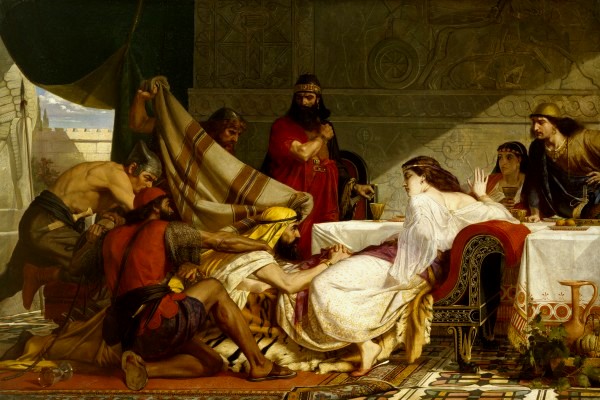
Esther draws away from a terrified Haman as he begs for his life. Too late. The implacable anger on Ahasuerus’ face tells the viewer that mercy will not be forthcoming.
Armitage has positioned the figures in this painting so that they all converge on the pale figure of Esther – who tries to draw herself away from them. Haman, the second most powerful man in the vast Persian Empire, has lost all sense of dignity and thrown himself at her feet, begging for mercy. Her pale right hand is raised in a gesture of refusal. There will be no mercy, and Haman himself will die on the very scaffold he has erected to hang her cousin Mordecai.
Bible reference: Book of Esther 7:1-10
‘Haman Begging Esther for Mercy’, Rembrandt, 1655
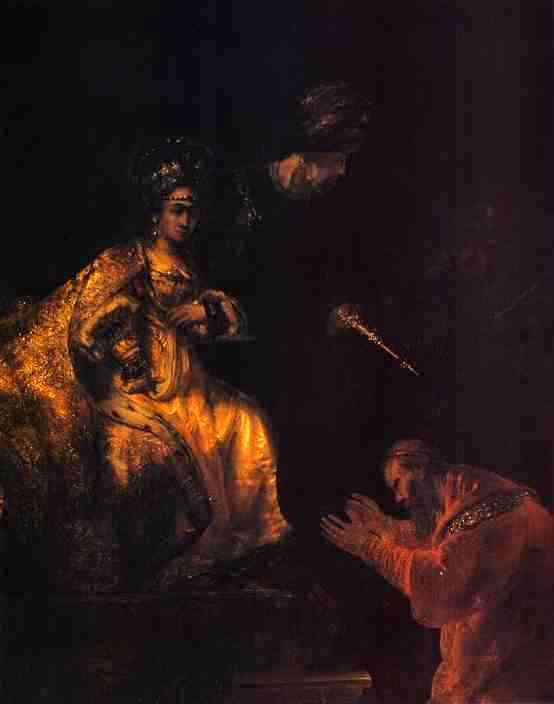
This is the moment of judgment. Haman begs for mercy, but he has been outmaneuvered by Esther, and must now die. The king, who has relied on Haman for many years, seems saddened by events, and by the fact that he must now sentence Haman to death.
Rembrandt has captured the implacable enmity that now exists between Esther and Haman. The expression on her face says it all. Haman has been check-mated, and his lowered status is plain. Ahasuerus seems to want to lower the royal scepter towards his old friend – an action that would signal forgiveness. But the scepter is frozen, and will not fall any further towards Haman’s head.
Bible reference: Book of Esther 7:1-10
Haman punished
‘The Punishment of Haman’, Michelangelo Buonarroti, 1511
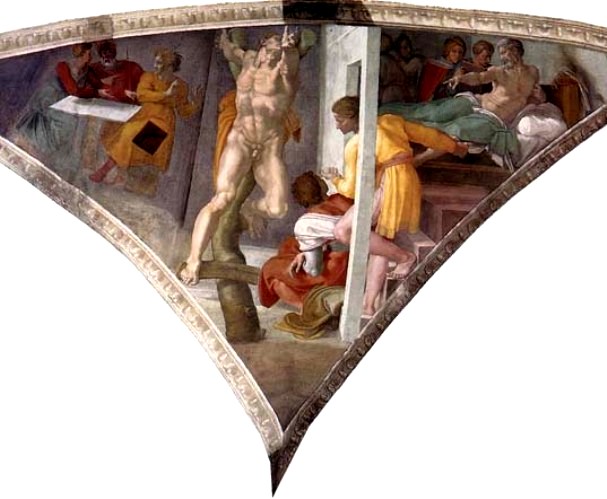
Haman is condemned to death and then strung up naked on the wooden gallows he had built to kill his enemy, Esther’s cousin Mordecai. To the left of his body, we see him at the tableThere are actually three scenes in the Haman picture because as well as seeing Haman punished, we see him at the table with Esther and the King and get a view of the King on his bed. The servants who have done the ghastly deed are on the steps, making a link between the scenes.
The interesting thing about Michelangelo’s depiction of the punishment of Haman is that he has changed the mode of execution: Haman is nailed to a rough wooden cross-beam, crucifixion-style with nails through his hands and feet, rather than hanging from the ‘gallows fifty cubits high’ that is mentioned in Esther 7:9. The reason for this change is that medieval and Renaissance theology saw the death of Haman as prefiguring the crucifixion of Jesus.
Bible reference: Book of Esther 7:1-10
Queen Esther, Bible heroine
‘Esther’, Minerva Teichert
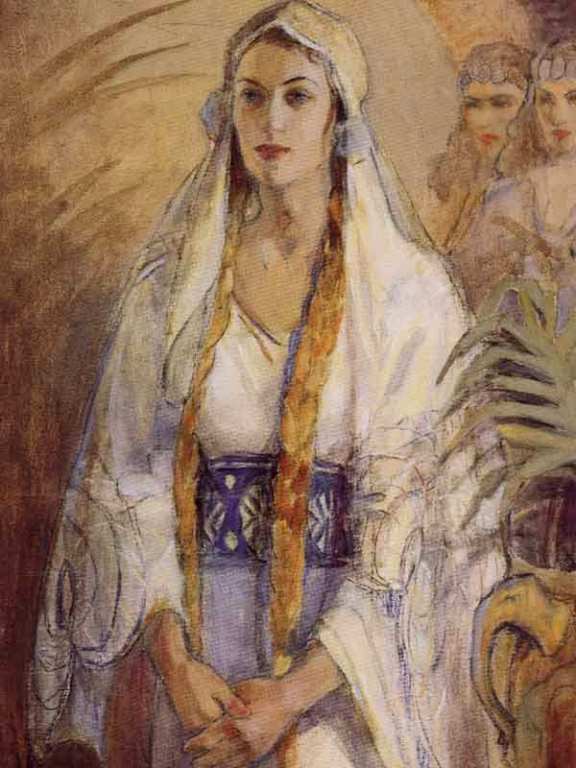
This image shows Esther in all her regal beauty. Since she is accompanied by two maid servants, the picture probably refers to Esther’s entrance into the throne room of her husband King Ahasuerus. Her calm dignity here says it all – see Bible Heroines for Esther as one of the Bible’s magnificent women.
You could Google Minerva Teichert for an interesting biography of her extraordinary life – well worth reading. Her problems and interests would be familiar to many women – not enough time to pursue her own career, but a burning desire to express her ideas and talent. She kept books for her family’s ranch, cooked for the workers on the ranch, raised their five children – and painted at night-time when her family was in bed. She explained her dedication with one sentence: “I must paint”.
Bible reference: Book of Esther
‘Esther’, Raanan, created 1990-2003
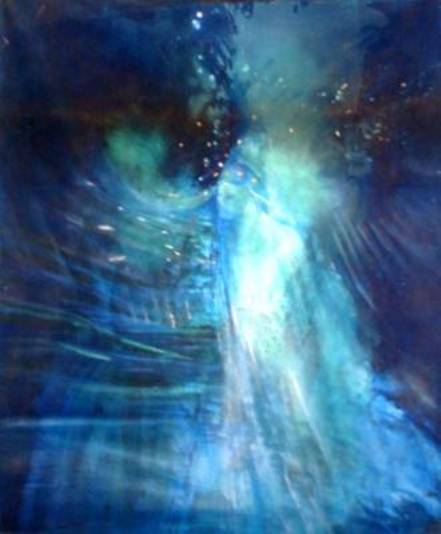
This seems to be an impression of what Esther is, and what she means to the Jewish people, rather than an image of one particular incident.
Esther is a swirling mass of color and beauty, glowing with light. This is the artist’s expression of what she was. Her Hebrew name ‘Hadassah’, comes from the word for ‘myrtle’, a tree whose leaves only release their fragrance when they are crushed; Esther’s full potential only appeared when she and her people were in terrible danger. The name ‘Esther’ means ‘hidden’: Esther’s real identity as a Jewess was hidden for years, and only revealed at the right moment. She was queen over herself and thus, the Bible suggests, suitable to be queen of others.
Bible reference: Book of Esther
‘Queen Esther’, Andrea del Castagno, 1450
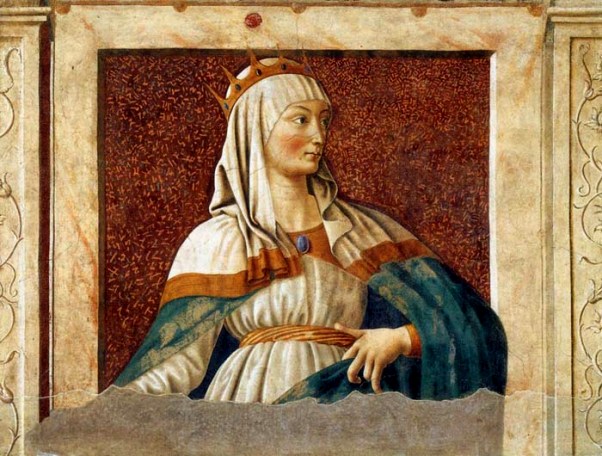
This is a painting depicting Queen Esther, the very model of a regal and dignified beauty.
This painting is from a loggia at the Villa Carducci Pandalfini, where Castagno painted a series on ‘Famous Men and Women’ (though the paintings are now housed in the Castagno Museum in Florence). He set the larger-than-life paintings within niches, so that they looked as if they were sculptures rather than paintings. The success of a great portrait/painting is that we feel that there is a real personality behind the face. Esther’s face in this painting is intelligent, wise and wary, all at the same time.
Bible reference: Book of Esther
Persian Lady, found at Persepolis, sculptor unknown, circa 515-338BC
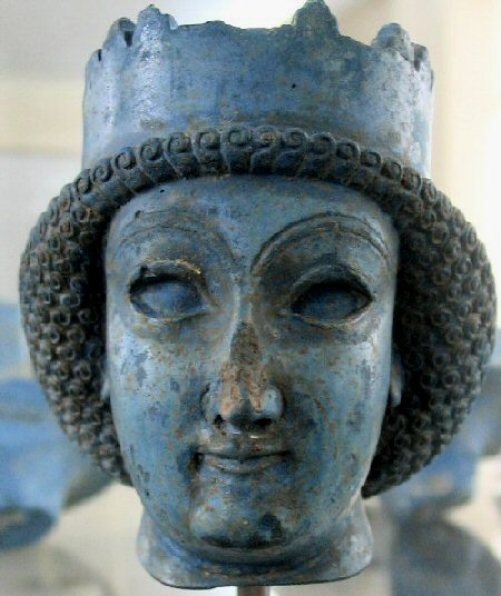
This is not, of course, an image of Esther. It is an archaeological artifact from the historical period and place in which her story is set. It is held by Archaeological Museum, Tehran
Hidden meanings in the paintings
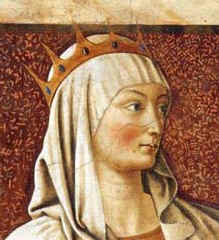 The story of Esther describes how a young Jewess interceded with a Persian king to prevent the massacre of her people. Her courage is still commemorated in the Jewish festival of Purim, when the story is read aloud in the synagogue.
The story of Esther describes how a young Jewess interceded with a Persian king to prevent the massacre of her people. Her courage is still commemorated in the Jewish festival of Purim, when the story is read aloud in the synagogue.- Esther’s pleading with the king was seen by Christians as a prefiguration of the Virgin, who would plead for people on the Day of Judgement.
- The story tells of King Ahasuerus (Xerxes) of Persia who dismissed his queen, Vashti, because she had offended him. The king held a nation-wide contest to find a suitable replacement,
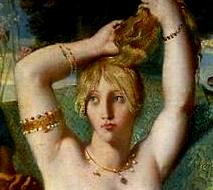 and he chose Esther, not knowing she was Jewish. Esther, an orphan, was ‘fair and beautiful’ and had been brought up by her cousin, Mordecai.
and he chose Esther, not knowing she was Jewish. Esther, an orphan, was ‘fair and beautiful’ and had been brought up by her cousin, Mordecai. - The king’s chief minister, Haman, hated all Jews, and set things up so that all Jews in the Persian Empire would die. Mordecai found out about it, and asked Esther to intercede with the king. This was not as simple as it sounds. To enter the king’s presence without being summoned was forbidden on pain of death, even to the queen, but Esther, having
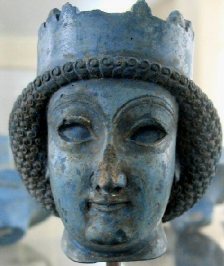 dressed in her finest robes, took her courage in both hands and entered the royal chamber. Ahasuerus held out his golden sceptre to signify that he would receive her and Esther, now safe, swooned with relief.
dressed in her finest robes, took her courage in both hands and entered the royal chamber. Ahasuerus held out his golden sceptre to signify that he would receive her and Esther, now safe, swooned with relief. - She invited the king to a banquet where she successfully interceded for her people. Haman was hanged on the same gallows he had prepared for Mordecai.
See Bible Archaeology: Palaces for photographs of the excavated palace of Persepolis, capital of ancient Persia – where Esther supposedly lived.
Wife Disobeys Husband!
‘Drunk with wine, he sent for his lovely queen, Vashti, to appear before the men.
She refused to come. Humiliated, the king banished her.
But he was lonely, so a beauty contest was held: the most beautiful girl would become his new queen.’
One night when the Persian king, Ahasuerus, was full of wine, he sent for his beautiful queen, Vashti, to show herself to his drunken friends.
She refused to come.
Outraged and egged on by his courtiers, the king banished her. But after a little while he became lonely, so the courtiers suggested that a beauty contest be held: the most beautiful girl would become his new queen.
A young Jewish girl called Esther was chosen. She was helped by her uncle Mordecai, but nobody knew that they were related, or that Esther was a Jewess. Mordecai was in the king’s favor, since he had once saved the king’s life.
But Mordecai had an enemy, a powerful man called Haman. Discovering that Mordecai was Jewish, Haman fed the mind of the king with ideas about people who were different. Under his influence, the king decided to execute all Jews in his kingdom – not realizing his beloved new queen Esther, and his savior Mordecai, were both Jewish.
Mordecai went to Esther and told her she must do something to save her people. She did not wish to, because it would place her own life in danger – she was not allowed, on pain of death, to go to the king unless she had been summoned. But she gathered her courage together, prayed, and dressed in her most splendid finery. Then she went to the king’s throne-room, and fortunately was embraced by him. She invited him to a special banquet where, of course, he would be the guest of honor. Haman was to come as well.
Haman and the king attended the banquet, and Ahasuerus promised Esther that she could have anything she wanted – even half his kingdom.
Esther asked that the king and Haman attend a second banquet. The king agreed. In high spirits, Haman returned to his home and ordered the erection of a gallows, to hang Mordecai.
Meanwhile, Esther’s banquet had started. Ahasuerus again promised Esther anything she wanted. She asked that her life be spared and her people saved. From whom? asked the King. From Haman, replied Esther.
Haman was trapped. He was taken out and hanged from the gallows he had built for Mordecai.
The Jews were not only saved from death: they could attack those people who had been their enemies, and claim their property. On the very day that they were to have been annihilated, they turned the tables by destroying all those who had sought to kill them. Thousands were killed, including the ten sons of Haman. From that day on, the Jewish people kept the day as a special festival called Purim.
Esther’s Story in the Bible
Esther with Additions, Chapter 2
A Nationwide Beauty Contest
1 After these things, the king’s anger abated, and he no longer was concerned about Vashti or remembered what he had said and how he had condemned her.
2 Then the king’s servants said ‘Let beautiful and virtuous girls be sought out for the king.
3 The king shall appoint officers in all the provinces of his kingdom, and they shall select beautiful young virgins to be brought to the harem in Susa, the capital. Let them be entrusted to the king’s eunuch who is in charge of the women, and let ointments and whatever else they need to given them.
4 And the woman who pleases the king shall be queen instead of Vashti. this pleased the king, and he did so.
5 Now there was a Jew in Susa the capital whose name was Mordecai son of Jair son of Shimei son of Kish, of the tribe of Benjamin;
6 he had been taken captive from Jerusalem among those whom King Nebuchadnezzar of Babylon had captured.
7 And he had a fost child, the daughter of his father’s brother, Aminadab, and her name was Esther. When her parents died, he brought her up to womanhood as his own. The girl was beautiful in appearance.
8 So, when the decree of the king was proclaimed, and many girls were gathered in Susa the capital in custody of Gai, Esther also was brought to Gai, who had custody of the women.
The Preparations
9 The girl pleased him and won his favor, and he quickly provided her with ointments and her portion of food, as well as seven maids chosen from the palace; he treated her and her maids with special favor in the harem.
12 Now the period after which a girl was to go to the king was twelve months. During this time the days of beautification are completed — six months while they are anointing themselves with oil of myrrh, and six months with spices and ointments for women.
13 Then she goes in to the king; she is handed to the persona appointed, and goes with him from the harem to the king’s palace.
14 In the evening she enters and in the morning she departs to the second harem, where Gai the king’s eunuch is in charge of the women; and she does not go in to the king again unless she is summoned by name.
Esther wins the Contest
15 When the time was fulfilled for Esther daughter of Aminadab, the brother of Mordecai’s father, to go in to the king, she neglected none of the things that Gai, the eunuch in charge of the women, had commanded. Now Esther found favor in the eyes of all who saw her.
16 So Esther went in to King Artaxerxes in the twelth month, which is Adar, in the seventh year of his reigh.
17 And the king loved Esther and she found favor beyond all the other virgins, so he put on her the queen’s diadem.
Esther with Additions, Chapter 14
Esther’s Prayer
1 Then Queen Esther, seized with deadly anxiety, fled to the Lord.
2 She took off her splendid apparel and put on the garments of distress and mourning, and instead of costly perfumes she covered her head with ashes and dung, and she utterly humbled her body; every part that she loved to adorn she covered with her tangled hair.
3 She prayed to the Lord God of Israel, and said: ‘O my Lord, you only are our king; help me, who am alone and have no helper but you.
Esther is Received by the King
1 On the third day, when she ended her prayer, she took off the garments in which she had worshiped, and arrayed herself in splendid attire.
2 Then, majestically adorned, after invoking the aid of the all-seeing God and Savior, she took two maids with her;
3 on one she leaned gently for support,
4 while the other followed, carrying her train.
5 She was radiant with perfect beauty, and she looked happy, as if beloved, but her heart was frozen with fear.*
6 When she had gone through all the doors, she stood before the king. He was seated on his royal throne, clothed in the full array of his majesty, all covered with gold and precious stones. He was most terrifying.
Esther Faints
7 Lifting his face, flushed with splendor, he looked at her in fierce anger. The queen faltered, and turned pale and faint, and collapsed on the head of the maid who went in front of her.
8 Then God changed the spirit of the king to gentleness, and in alarm he sprang from his throne and took her in his arms until she came to herself. He comforted her with soothing words, and said to her,
9 ‘What is it, Esther? I am your husband. Take courage;
10 You shall not die, for our law applies only to our subjects. Come near”.
11 Then he raised the golden scepter and touched her neck with it;
12 he embraced her, and said ‘Speak to me….’
* Note: There was a law that anyone coming unbidden into the King’s presence would be instantly killed. Esther had not been bidden to his presence, and therefore risked death.
Save
Save
Save
Save
Save
Save
Save
Save
Save
Bible Art: Paintings and Artworks from the Old and New Testament: Esther, Mordecai and the Feast of Purim: Bible Study Resource
Esther – some questions
What was Esther’s story about? Why was it remembered? to warn? to explain? to comfort? Why did this story appeal to people?
Esther paintings links
Paintings by
‘Much of that gold turned out to be priceless jewelry draped around the skeleton of a young princess named Yabahya. Nearby, still more jewelry and gold ornaments were piled. Mingled with the dried bones were dozens of delicately sculpted gold rosettes, scattered like flowers over the body of the dead princess…’
‘Now he will choose a second wife for her beauty and virtue – all very fine, but not when the woman in question is to be queen of a vast empire. She, like Anne Boleyn, will need more than beauty and virtue to navigate the shoals of a corrupt and dangerous court…’
© Copyright 2006
Elizabeth Fletcher

